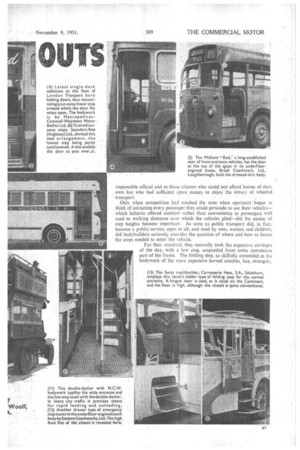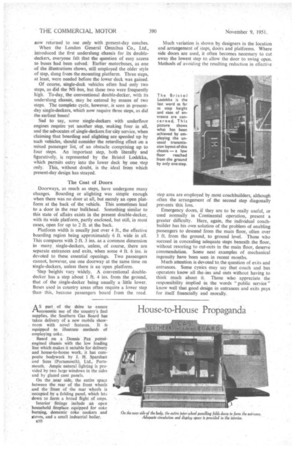"TEPS must be taken," say the formulators of proposals, "to render
Page 42

Page 43

Page 44

If you've noticed an error in this article please click here to report it so we can fix it.
S boarding and alighting from .public service vehicles safer for all."
. Unfortunately for the force of their altruistic intentions, that is exactly . the position; steps must always be taken in boarding and alighting from public service vehicles, and it is often these steps which cause, or at least. contribute to; accidents.
From the early days of public transport, operators have realized that convenience in reaching the interior of a vehicle is a prime factor in traffic promotion. At first, when horsed buses of various kinds plied along the roads, over 100 years ago, only a special type of passenger was catered for. The early providers of public transport were not so muCh interested in the public as might be imagined. Wide variations in standards of living, in those days, restricted the possible passenger potential to the reasonably well-to-do business man, to the riot-quite-so-well-off gentleman, to the responsible official and to those citizens who could not afford horses of their own but who had sufficient spare money to enjoy the hixbry of wheeled transport.
Only when competition had reached the state when operators begin to think of attracting every passenger they could persuade to use their Vehicles— which hitherto offered comfort rather than convenience to passengers well used to walking distances over which the vehicles plied—did the matter of step heights become important. As soon as public transport did, in fact, become a public service, open to all, and used by men, women and children, did bodybuilders seriously consider the question of where and how to locate the steps needed to enter the vehicle.
For their standard, they naturally took the expensive carriage; of the day, with a low step, suspended from some convenient part of the frame. The folding step, so skilfully concealed in the bodywork ofthe more expensive horsed coaches, has, strangely, now returned to use only with present-day coaches.
When the London General Omnibus Co., Ltd, introduced the first underslung chassis for its doubledeckers, everyone felt that the question of easy access to buses had been solved. Earlier motorbuses, as one of the illustrations shows, still employed the older style of step, slung from the mounting platform. Three steps, at least, were needed before the lower deck was gained.
Of course, single-deck vehicles often had only two steps, as did the NS bus, but these two were frequently high. To-day, the conventional double-decker, with its underslung chassis, may be entered by means of two steps. The complete cycle, however, is seen in presentday single-deckers, which now require three steps, as did the earliest buses!
Sad to say, some single-deckers with underfloor engines require yet another step, making four in all, and the advocates of single-deckers for city service, when claiming that boarding and alighting are speeded up by such vehicles, should -consider the retarding effect on a mixed passenger list, of an obstacle comprising up to four steps. An important step, both literally and figuratively, is represented by the Bristol Lodekka, which permits entry into the lower deck by one step only. This, without doubt, is the ideal from which present-day design has strayed.
The Cost of Doors
Doorways, as much as steps, have undergone many changes. Boarding or alighting was simple enough when there was no door at all, but merely an open platform at the back of the vehicle. This sometimes lead to a door in the rear bulkhead. Something similar to this state of affairs exists in the present double-decker, with its wide platform, partly enclosed, but still, in most cases, open for up to 2 ft, at the back.
Platform width is usually just over 4 ft., the effective boarding region being approximately -6 ft. wide in all. This compares with 2-ft. 3 ins, as a common dimension in many single-deckers, unless, of course, there are separate entrances and exits, when some 4 ft. 6 ins, is devoted to these essential openings. Two passengers cannot, however, use one doorway at the same time on single-deckers, unless there is anopen platform.
• 'Step heights vary widely. A conventional doubledecker has a step about 1 ft. 4 ins. from the ground, that of the single-decker being usually a little lower. Buses used in country areas often require a lower step than this, because passengers board from the road.
Much variation is shown by designers in the location and arrangement of steps, doors and platforms. Where side doors are used, it often becomes necessary to cut away the lowest step to allow the door to swing open. Methods of avoiding the resulting reduction in effective step area are employed by most coachbuilders, although often the arrangement of the second step diagonally prevents this loss.
Emergency doors, if they are to be really useful, or used normally in Continental operation, present a greater difficulty. Here, again, the individual coachbuilder has his own solution of the problem of enabling passengers to descend from the main floor, often over 3 ft. from the ground, to ground level. Those who succeed in concealing adequate steps beneath the floor, without resorting to cut-outs in the main floor, deserve commendation. Some neat examples of mechanical ingenuity have been seen in recent months.
Much attention is devoted to, the question of exits and entrances. Some cynics may say that coach and bus operators know all the-ins and outs without having to think much about it. Those who appreciate the responsibility implied in the words "public service" know well that good design in entrances and exits pays for itself financially and morally.




















































































